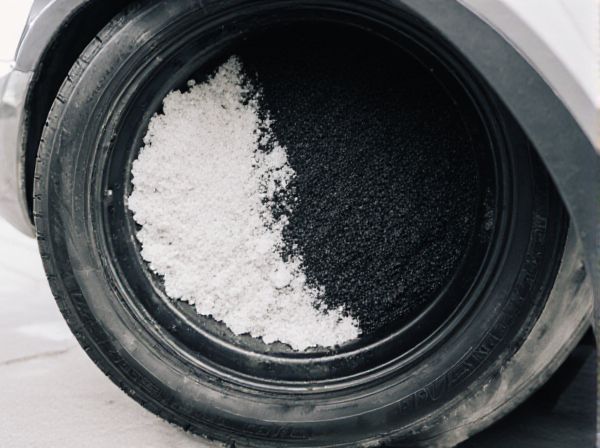
Photo illustration: Silica Compound vs Carbon Black Compound
Silica compound offers improved wet traction and reduced rolling resistance, enhancing fuel efficiency and wet grip performance compared to carbon black compound. Carbon black compound excels in durability and abrasion resistance, making it ideal for heavy-duty and high-wear applications. Your choice depends on prioritizing either fuel economy and wet performance or toughness and longevity in tire or rubber product applications.
Table of Comparison
| Feature | Silica Compound | Carbon Black Compound |
|---|---|---|
| Grip on Wet Surface | High | Moderate |
| Rolling Resistance | Low (Improves Fuel Efficiency) | High |
| Durability | Moderate | High |
| Heat Resistance | Moderate | High |
| Traction on Dry Surface | Good | Excellent |
| Environmental Impact | Lower CO2 Emissions | Higher CO2 Emissions |
| Common Use | Fuel-efficient and Wet-weather Tires | Durable and Performance Tires |
Introduction to Silica and Carbon Black Compounds
Silica and carbon black compounds are essential fillers used in rubber and tire manufacturing to enhance performance properties. Silica compounds improve rolling resistance and wet traction due to their high surface area and polar nature, while carbon black compounds provide superior abrasion resistance and tensile strength attributed to their reinforcement capabilities. Selecting between silica and carbon black compounds depends on the desired balance of mechanical strength, durability, and fuel efficiency in the final product.
Chemical Structure and Composition
Silica compounds consist primarily of silicon dioxide (SiO2) particles with hydroxyl groups on their surface, enhancing their interaction with rubber matrices and improving wet traction and rolling resistance in tires. Carbon black compounds are composed of finely divided elemental carbon particles with fused aromatic rings, which provide superior reinforcement and abrasion resistance due to their high surface area and strong carbon-carbon bonding. The chemical structure of silica leads to polar interactions, whereas carbon black's non-polar carbon network favors dispersion through physical forces, influencing the performance characteristics of rubber compounds.
Manufacturing Processes of Silica and Carbon Black
Silica used in tire manufacturing is produced primarily through the precipitation process from sodium silicate and acid, resulting in precipitated silica with high surface area and specific particle size distribution crucial for enhancing tire performance. Carbon black is manufactured via the incomplete combustion or thermal decomposition of hydrocarbons, typically from petroleum or natural gas, resulting in fine carbon particles with controlled structure and surface area that improve tire strength and durability. The differing manufacturing methods produce materials with distinct physicochemical properties, directly impacting polymer reinforcement and wet traction in tire compounds.
Key Differences in Physical Properties
Silica compounds exhibit lower hysteresis and better wet traction compared to carbon black compounds, resulting in improved fuel efficiency and enhanced grip on wet surfaces. Carbon black compounds have higher tensile strength and abrasion resistance, offering superior durability and wear performance in tire applications. Silica compounds generally provide lower rolling resistance, while carbon black compounds contribute to increased stiffness and heat dissipation.
Performance in Tire Applications
Silica compounds in tire applications significantly enhance wet traction and reduce rolling resistance compared to carbon black compounds, contributing to improved fuel efficiency and safety. Carbon black compounds offer superior abrasion resistance and durability, making them ideal for heavy-duty tires requiring high wear resistance. The balanced integration of silica and carbon black in tire tread formulations optimizes overall performance by leveraging silica's grip benefits with carbon black's toughness.
Environmental Impact and Sustainability
Silica compounds in tire manufacturing significantly reduce rolling resistance, leading to lower fuel consumption and decreased CO2 emissions compared to carbon black compounds. Silica is derived from abundant natural sources, offering enhanced sustainability by improving tire longevity and reducing raw material reliance. Carbon black production involves fossil fuel consumption and emits higher greenhouse gases, making silica compounds a more environmentally friendly choice in sustainable tire technology.
Cost Comparison and Economic Considerations
Silica compounds generally have higher upfront costs compared to carbon black compounds due to more complex processing and raw material expenses, impacting initial investment decisions. However, silica compounds offer improved fuel efficiency and lower rolling resistance in tire applications, which can result in long-term cost savings and better economic value. Carbon black compounds remain favored for their lower material cost and ease of processing, making them a cost-effective choice for high-volume, budget-sensitive production runs.
Impact on Rolling Resistance and Fuel Efficiency
Silica compounds significantly reduce rolling resistance compared to carbon black compounds due to their lower hysteresis properties, directly enhancing fuel efficiency in vehicles. Tires formulated with silica show improved wet traction and durability while maintaining lower energy loss during rotation. This reduction in rolling resistance translates to measurable decreases in fuel consumption and CO2 emissions, making silica compounds a preferred choice for eco-friendly tire designs.
Durability and Wear Resistance
Silica compounds exhibit superior durability and wear resistance due to their enhanced heat dissipation and reduced hysteresis compared to carbon black compounds. Carbon black compounds provide excellent abrasion resistance but tend to generate more heat, leading to faster degradation under high-stress conditions. The silica compound's molecular structure contributes to longer tire life and improved performance in wet conditions, making it ideal for applications requiring extended wear resistance.
Future Trends in Compound Development
Silica compounds are increasingly preferred over carbon black compounds due to their superior rolling resistance and wet traction, aligning with the growing emphasis on fuel efficiency and environmental regulations in tire manufacturing. Innovations in nano-silica and hybrid fillers are driving enhanced durability and performance in silica-based compounds, addressing challenges like wet grip and wear resistance. Research into sustainable and bio-based silica sources highlights the trend toward eco-friendly compound development, positioning silica compounds as the future standard in high-performance tire applications.
 caratoz.com
caratoz.com